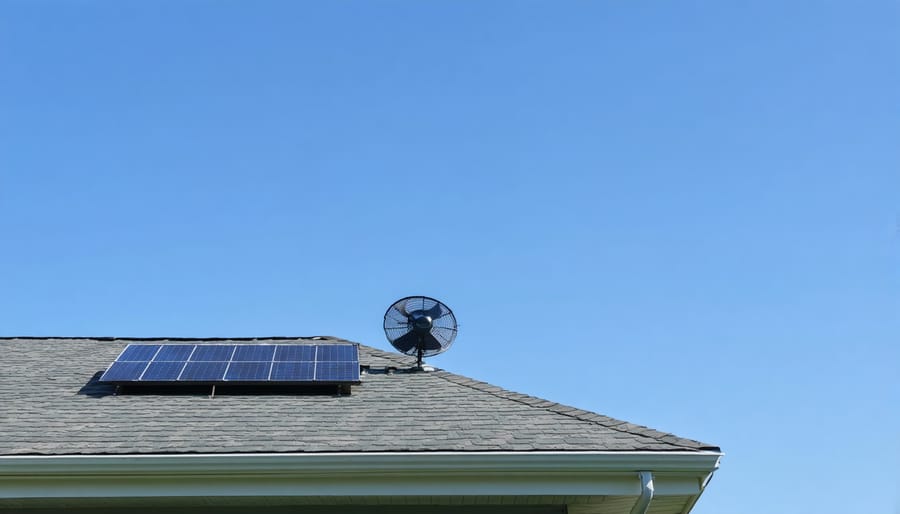Solar vs Electric Attic Fan – A Full Comparison
Updated:

While solar attic fans outdo electric attic fans in eco-friendliness, electric attic fans outshine them by being more powerful.
Beyond eco-friendliness and ventilation capacity, solar-powered attic fans and electric fans have different initial costs. Their operating costs, ease of installation, maintenance needs, and warranties also differ. These differences are often the deciding factors in a person’s choice between a solar attic fan and an electric fan.
Eco-Friendliness
The primary distinction between a solar attic fan and an electric attic fan is eco-friendliness.
Solar fans run on electricity generated from solar energy captured by a solar panel. Electric fans, on the other hand, typically use electricity generated from natural gas, coal, and nuclear energy.
While the sun’s energy is renewable, natural gas, nuclear energy, and coal are non-renewable. Therefore, as time passes, our environment may not have enough coal, nuclear energy, or natural gas to generate electricity.
Besides being less sustainable, coal, nuclear energy, and natural gas typically give off byproducts that can be harmful to the environment. But solar energy does not generate environmental waste. Hence, the eco-friendliness of solar attic fans.
Ventilation Capacity
The attic ventilation capacity of solar fans is generally less than that of electric attic fans. This is why you will typically get more CFM (cubic feet per minute) from an electric fan than from a solar-powered attic fan of a similar size.
Most solar-powered attic fans have ventilation capacities ranging from 800 to 1200 CFM (of course, the capacities of some products are far above this range). But many electric fans have higher ventilation capacities, ranging from 1600 CFM and higher. So, more times than not, you will need more solar fans to match the ventilation capacity of electric attic fans for the same attic space.
Initial Cost
Solar-powered attic fans are generally more expensive than electric fans. For this reason, the initial cost of a solar attic fan is typically higher than the cost of an electric attic fan.
On average, you may have to spend around $300 to $600 on a single solar fan unit. A single electric fan unit, on the other hand, costs around $100 to $200.
Besides the cost of the fan, the installation costs of electric fans and solar fans differ. Electric vents may be more expensive to install than solar fans because you may have to spend on electrical supplies, inspection, and some other things. Such extra costs are typically absent with solar fans.
Operating Cost
By removing hot air from your attic and dropping attic temperatures, both solar and electric attic fans can make your home’s heating and cooling system more energy-efficient. In other words, they can make you spend less to keep your home cooler or warmer. Still, their operating costs are pretty far apart.
If you are using an electric attic ventilation fan, you are most likely going to spend more to remove the heat and humidity in your attic. But if you use a solar-powered attic fan, you will save money on operating costs.
Solar fans run on energy from the sun, which is free. So, you incur no costs for running them. Conversely, electric attic fans use mains electricity, so they add to your energy bill. Besides, while most electric fans come with thermostats that regulate their operation, some don’t.
In fans with a thermostat, the fan stops when the attic temperature reaches a threshold. But those without thermostats keep working until there is a power outage or the unit becomes faulty. Because they keep working without stopping, electric fans without a thermostat typically consume a lot of energy. So, their operating costs are usually very high.
Ease of Installation
Generally, installing solar attic fans is easier than installing electric attic fans. Like many other homeowners, you might even be able to install your solar fan yourself.
On the flip side, if you are not familiar with electrical wiring and circuits, you should let a professional install your electric vent.
Maintenance
Solar attic fans are generally low-maintenance, and they usually have a longer lifespan than electric vents. This is all thanks to the fact that they typically use inductive motor, which experiences minimal wear.
An electric fan will generally require more maintenance than a solar fan. One reason for this is that electrical vents run for longer periods. And while some electric vents come with thermostats to stop them at intervals, the recurrent on-and-off cycles can be problematic.
Noise
While electrical vents can generate more power to remove hot air from your attic and bring the temperature down, they are relatively noisier than solar vents. While running, they may make a humming sound, which can be uncomfortable.
Thanks to their brushless motors, solar attic vents are generally noiseless. You can get proper ventilation with them without irksome hums.
Warranty
The warranty duration of a solar attic vent is typically longer than an electrical vent. In many cases, the warranty of solar attic is over 10 years. But for electrical attic fans, the warranty period is usually 1 year.
FAQs
Is Solar or Electric Attic Fan Better?
The better option between both choices depends on what you want. If you want to save on power bills while preserving the environment, solar fans are the best solution. But if you want a powerful and inexpensive attic cooling device, electrical fans are better.
Is a Solar Powered Attic Fan Worth It?
Solar-powered attic fans work by using free energy from the sun. They help regulate attic temperature while helping you save on operation costs. So, for most homeowners, a solar fan is worth it.
Do Solar Attic Fans Cool Your House?
Solar attic fans may not cool your house directly. However, they can help make the cooling system in the main areas of your house more efficient by removing heat from your attic.
Conclusion
Solar fans offer low operation costs, low maintenance, eco-friendliness, longer warranty periods, noiseless operation, and they can be installed readily. However, they are more expensive to buy and are relatively less powerful than electrical roof vents.
On the other hand, electric fans come with high operation costs, high maintenance needs, and shorter warranty periods. They may also make humming sounds during their operation and require more steps for installation.










